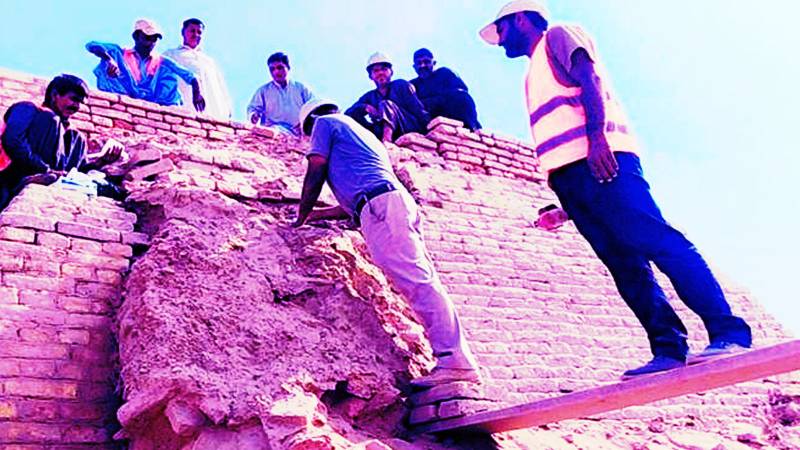
In August 2022, the Mohenjo-Daro World Heritage Site received disastrous rainfall up to 779.5 mm, that seriously affected the archaeological remains. The intensity of heavy monsoon rains caused severe structural damage, including collapse of walls, developing cavities and holes in structures due to loss of mud and bricks, erosion of slopes and mud pushta, and weakening of the foundations of walls and structures at the Mohenjo-Daro Site. These heavy rains also affected the drainage system.
UN Secretary General Antonio Guterres visited the Mohenjo-Daro Archaeological Site on Saturday, 10 September 2022. He was flanked by Foreign Minister of Pakistan Bilawal Bhutto Zardari, CM Sindh Syed Murad Ali Shah, Culture Minister Syed Sardar Ali Shah, DG Archaeology Sindh Manzoor Ahmed Kanasro. Dr Kalimullah Lashari briefed the UN Secretary General and world media about the damages at Mohenjo-Daro due to heavy rains and floods. The UN Secretary-General assured all possible support to Government of Sindh for the protection of the pre-historic site. With the technical and financial support of UNESCO Islamabad Office and the Directorate of Archaeology and Antiquities Government of Sindh, conservation work was started in early 2023 in full scale.
During conservation work in the Stupa Area on Wednesday 15 November 2023, a pottery vessel was identified by the team. Salvage excavation was started on the special directions of Director General Archaeology Sindh Manzoor Ahmed Kanasro and Director Archaeology Abdul Fattah Shaikh. The team was led by Director Mohenjo-Daro Dr Syed Shakir Ali Shah. Other members of the team comprised Allah Dino Soomro (Site Attendant SD Area), Mashooque Ali Channo (Mason), Imtiaz Ali Dombki (Conservation Assistant), Ghulam Shabir Joyo (Archaeological Conservator), Ali Hyder Gadhi (Archaeological Engineer), Syed Ghayoor Abbas Shah (Curator), Naveed Ahmed Sangah (Architect), Sheikh Javed Ali Sindhi (PRO/Guide), Rustam Ali Bhutto (Laboratory Assistant), Aijaz Ali Mashori (UDC), Rahim Bux Wassan (Supervisor) and others.
A hoard of copper coins was found when labourers were clearing debris from a collapsed wall in the west of the Buddhist Stupa in the SD Area at Mohenjo-Daro. These ancient coins were unearthed inside a pottery vessel behind Chamber 29A on the west side of the Buddhist Stupa. This discovery was made at 13 feet 7 inches height from the ground level of Divinity Street in Section A of SD Area. The Buddhist monks’ cells stood 5 feet 9 inches above this point. The terracotta bowl/vessel that contained these copper coins had a height of 4 inches (10 cm) with diameter 9 inches (22 cm). The bowl was found broken and the pieces were also submitted to Water and Soil Investigation Laboratory (WASIL) at Mohenjo-Daro along with the rest of the coins. The strata data had been carefully documented along with proper tools and measurements. No Brahmi inscriptions were found on pottery vessel fragments during excavation work.
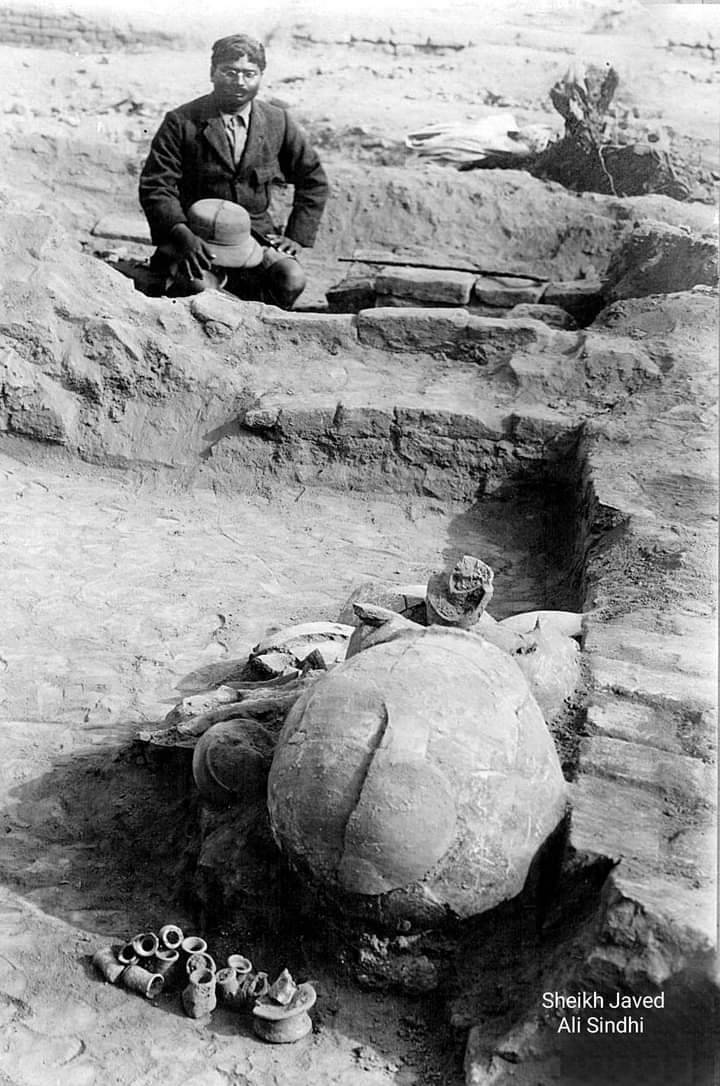
ASI Officer NG Majumdar had also discovered hoard of Kushan coins during the excavation of Divinity Street between 1927 to 1931. This hoard of coins was found in a pink paste vessel (6.3 inches high) at the level 15.7 feet above datum beneath the floor of Room 1of the Buddhist Monastery. These coins numbered 1,078 in all. Despite being in a jar these were very badly corroded. NG Majumdar carefully examined them and reported that they do not differ in legend or type from those already found in the Stupa section (Mackay 1931: 15 & 16) He also found some inscribed drinking bowl sherds of Buddhist date (2nd to 3rd century AD) that bear Brahmi inscriptions. These had been deciphered by NG Majumdar. Some of these inscriptions were translated as follows:
Plate LXXI: 2, 11, 16, 17, 18, 19 & 20.
No. 2 (SD 2951)
Brahmi Inscription: “Bhadata (Sangha) rakshasa ayu kara (ka)”.
English Translation: “This is the drinking vessel of the venerable Samgharaksha.”
No. 11 (SD 3088)
The human figure painted in white on the polished black slip of the grey pottery probably has no real meaning.
No.16 (SD 2791)
Brahmi Inscription “Pravrajitasa…”; English “of the ascetic…”
No. 17 (SD 2737)
Brahmi Inscription “Bhadamta Buddharakshitasa”; English “of the Venerable Buddharakshita.”
No. 18 (SD 2738)
Brahmi Inscription “…Tasa Sagharkshitasa ida karaka”; English “this is the drinking vessel of Samgharakshita...”
No. 19 (SD 2856)
Brahmi Inscription “Pravrajitasa Muttakasa ima...”; English “this (drinking vessel) of the ascetic Muttaka (Muktaka)…”
No. 20 (SD 2740)
Brahmi Inscription “Pravrajitasa”; English “of the ascetic…”
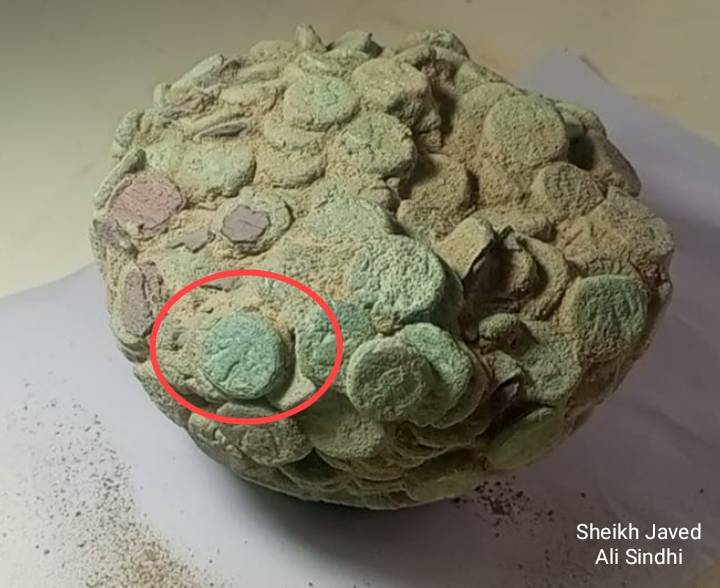
Significance of this discovery for the archaeological community
According to my research, most probably these coins belong to the Kushan period. Previously a total of 4,348 copper coins of same type were excavated by RD Banerji (2,170 coins), Sir John Marshall (1,100 coins) and Mackay (1,078 coins) from 1922 to 1931.
These coins were issued by Buddhist Kings of the Kushan period, namely Kadaphises, Kanishka I, Huvishka and Vasudeva I, from the 2nd to 5th century AD. On their backside were Siva, bull, thorned goddess, nimbate figure, trident, the cross, a series of pellets and fire altars. NG Majumdar wrote a note on the copper coins found from the Stupa area of Mohenjo-Daro, which was included by Sir John Marshall in his book Mohenjo-Daro and the Indus Valley Civilization (1931).
A short history of the Kushan Kings of India
Heraios was a Kushan chief who lived from 1 to 30 AD. He was succeeded by Prince Kujula Kadaphises-I, who was born in 30 AD in Bactria and died around 80 AD. He was the founder of the Kushan dynasty of Central Asia and India. Vima Kadphises was followed by Vima Taktu or Sadashkana, Vima Kadphises-II, Kanishka-I, Huvishka, Vasudeva-I, Kanishka-II, Vasishka, Kanishka-III, Vasudeva II, Mahi, Shaka and Kipunada. They ruled from 30 AD to 350 AD. Their Capitals were Peshawar (Puruspura), Taxila (Taksasila) and Mathura (Mathura). Their official languages were Greek, Bactrian, Gandhari Prakrit and Hybrid Sanskrit. While Buddhism, Hinduism and Zoroastrianism were the main religions in Kushana Empire.
The Kushans were subjugated by the Sasanians, Guptas and Hepthalites. They ruled from Xinjiang (China), Tibet, Tajikistan, Kyrgyzstan, Uzbekistan, Turkmenistan, Kazakhstan, Afghanistan, Pakistan and India. Major cities with mints were most probably Balkh, Surkh Khotal, Kapisa (Begram), Peshawar (Puskavalati), Taxila, Kanishkapura, Sagala (Sialkot) and Mathura.
Xuanzang Travels to Buddhist Kingdom of Sindh in 641 AD
During Sasanian rule in Iran, the Buddhist kings of Rai Dynasty ruled over Sindh from 499 to 641 AD. It was the time when Chinese traveller Xuanzang visited Buddhist shrines in Sindh. Chinese Buddhist monk Xuanzang (alternatively transcribed Hiuen Tsang or Xuan Tsang) was born in 602 AD. In the year 627 AD, he travelled overland from China to India to obtain Buddhist scriptures. He returned to China in 645 AD after finding 124 books on the Great Vehicle which had to be carried on 22 horses. He documented his travels in his book SI YU KI (Notes of the Western World). Xuanzang died in 664 AD. During his travels he visited different holy places in modern day countries like Nepal, Bangladesh, India, Pakistan and Afghanistan.
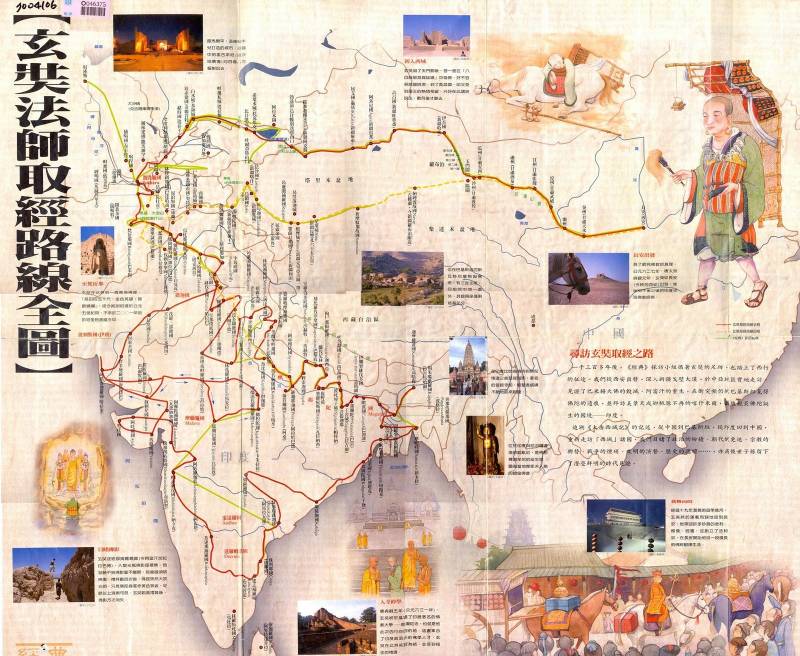
After visiting “U she yen na” (Ujjayani), “Mo hi shi fa lo po lu” (Mahesvarapura) and “Kiu che lo” (Kachh Gujarat) entered Sin tu (Sindh) In 641 AD. King Rai Sahasi II was ruling the Kingdom of Sindh. He writes in his book:
“SIN TU (Sindh): This country is about 7,000 li in circuit; the capital city, called Pi shen pop u lo, is about 30 li round. The soil is favourable for the growth of cereals and produces abundance of wheat and millet. It also abounds in gold and silver and native copper. It is suitable for the breeding of oxen, sheep, camels, mules, and other kinds of beasts. The camels are small in size and have only one hump. They find here a great quantity of salt, which is red like cinnabar; also white salt, black salt and rock salt. In different places, both far and near, this salt is used for medicine. The disposition of the men is hard and impulsive; but they are honest and upright, they quarrel and are much given to contradiction.
They study without aiming to excel; they have faith in law of Buddha. There are several hundred Sangharamas, occupied by about 10,000 priests. They study the Little Vehicle according to the Sammatiya School. As a rule, they are indolent and given to indulgence and debauchery. Those who are very earnest as followers of the virtue of the sages live alone in desert places, dwelling far off in the mountains and forests. There night and day they exert themselves in aiming after the acquirement of the holy fruit (of Arhatship). There are about 30 Deva temples, in which sectaries of various kinds congregate.
The king is of the Sudra (Shu to lo) caste. He is by nature honest and sincere, and he reverences the law of Buddha. When Tathagatha was in the world, he frequently passed through this country; therefore Asok Raja has founded several tens of Stupas in places where the sacred traces of presence were found. Upagupta, the great Arahat, sojourned very frequently in this kingdom, explaining the law and convincing and guiding men. The places where he stopped and the traces he left are all commemorated by the building of Sangharamas or the erection of Stupas. These buildings are seen everywhere; we can only speak of them briefly.”
[See: SI YU KI Buddhist Records of the Western World, Translated from the Chinese of Xuanzang (AD629) By Samuel Beal, Vol 2 London 1884, pages 272 to 274)]
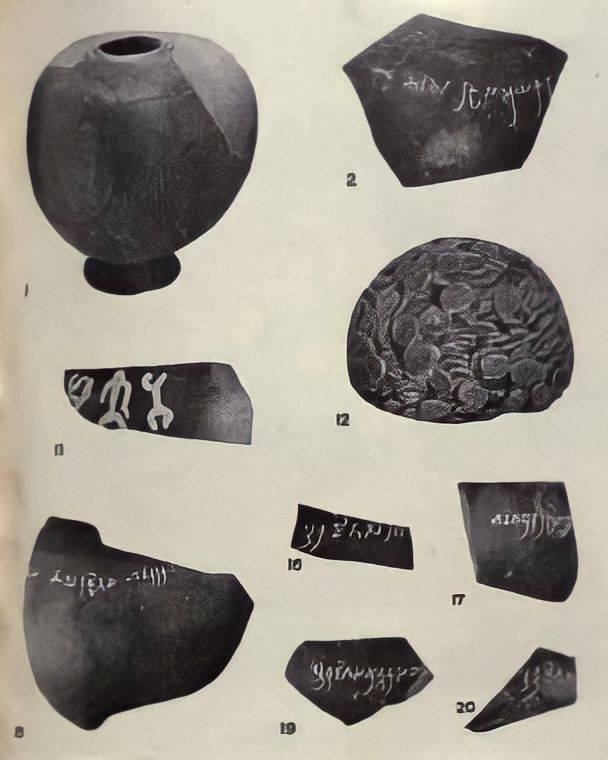
Analysis of the copper coin hoard: insights into ancient trade or economics
The hoard consists of round copper pieces, thinner in shape. Trade and commerce activities during Kushan rule in India were at their peak. Gold coins were used for international trade. Kushan Kings had circulated copper coins in huge quantity for internal trade and economic activities. Copper coins called Drachma were minted up to 230 AD.
Besides Buddhist Stupas and Monasteries, the Kushan kings favoured the growth of early urban sites in Sindh. Several Buddhist monasteries throughout the Kushan realm received funds for maintenance of stupas and pilgrims’ expenses.
Challenges in the excavation and preservation of the ancient coins
Coins from an excavation present special problems and challenges. During the November 2023 salvage excavation work, we faced some problems and challenges.
On the special directions of Director General Archaeology Sindh Manzoor Ahmed Kanasro, excavation work at the Stupa area was started on an emergency bases. When Dr Syed Shakir Ali Shah returned from Sukkur, he started excavation in the evening time. The sun had set and so light for visibility became an issue. Hence torches were used for this purpose.
The work continued for three hours from 6:00 pm to 9:00 pm. As the hoard was hanging between Divinity Street and Buddhist Stupa at a height, finding out the proper context of the finding was necessary. So, the remaining work was postponed for next morning ie on Thursday 16 November 2023.
Working and standing for hours on wooden planks was another issue. During this process, the police was called for the protection of the treasure trove. Besides this, night watchmen were also tasked to perform their duties with extra vigilance.
The remaining work of excavation was started next morning during day light. After measurements, the recovery of pottery vessels full of coins was done with scientific tools and apparatus. Some media persons were also present during the activity. It was necessary to remove the soiled deposits, encrustations and corrosion layers covering these coins.
Now began the process of study and dating of the coins. It was necessary to reveal the decoration and inscriptions on these coins. The hoard of copper coins was sent to laboratory for further investigations. It was followed by 1) Examination 2) Mechanical cleaning 3) Preservation and 4) Consolidation.
Impact of this new discovery on the overall understanding of the site
The discovery of this hoard of copper coins will shed new light on Buddhism in Sindh. By conducting investigation and research, we can understand better the Kushan Empire, its kings and deities. We can learn about Buddhist art and its themes. We may also know about saved stashes of money in monasteries, monks’ cells and other sites. We can fill the gaps of the forgotten history of Buddhist Sindh.
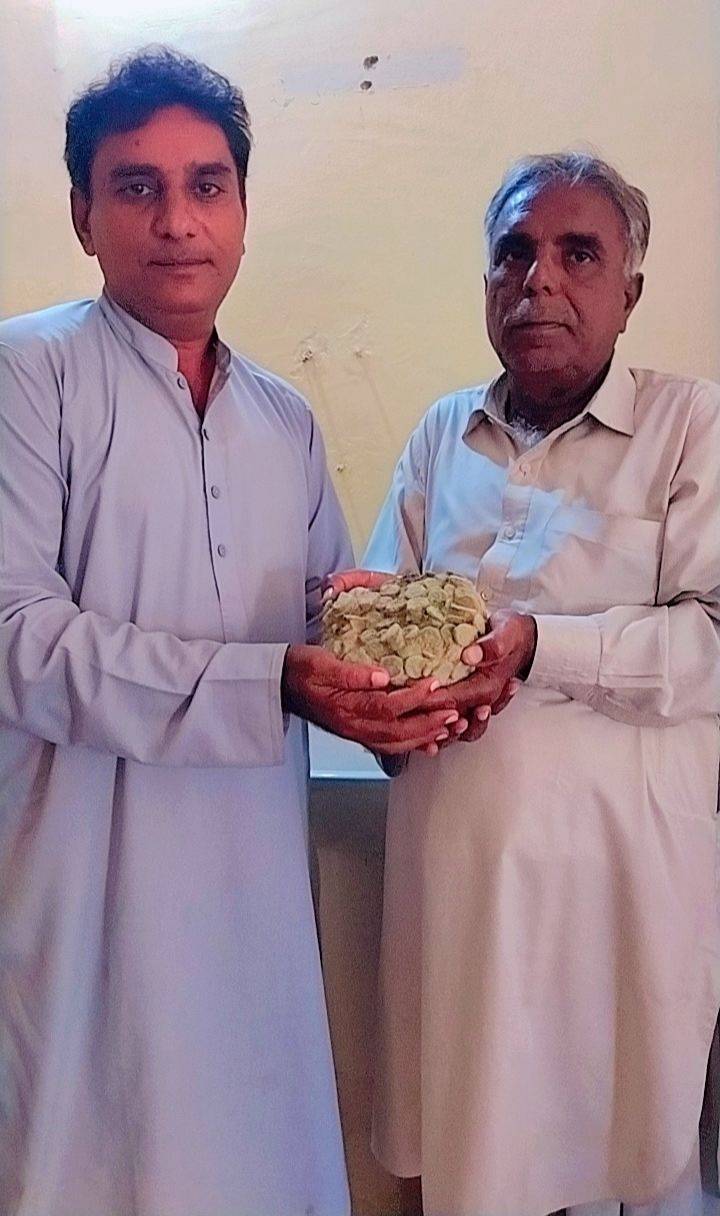
Through such work, research the importance of Mohenjo-Daro will be increased for national and foreign tourists. It would become possible to engage universities, institutions and research scholars for future explorations. We used to read about the discoveries of copper coins during British colonial period, but now we are excavating the same treasures by our own hands. This is a great joy and honour for us!
Coin identification by Kushan Period experts
The present discovery is the most remarkable one of its kind after 93 years. Through this work, we can understand social, cultural, economic and religious conditions of Sindh province under the Kushan Empire.
Previously a large number of copper coins belonging to King Vasudeva I, were found from the Buddhist Monastery of Mohenjo-Daro. This Buddhist stupa and monastery was built in 150 AD and abandoned in 500 AD. It belonged to the Mahayana sect of Buddhism.
According to my own research, this recently excavated (November 2023) hoard of coins was deposited in monks’ cells most probably during the reign of King Vasudeva I, who ruled from 191 to 227 AD. Only a few coins have been cleaned so far in Mohenjo-Daro Laboratory.
One of these coins belongs to the period of Kushan King Vasudeva I. Another coin was issued by King Kanishka II, dated 227 to 246 AD. Dr Gul Rahim Khan has also identified them with issues by King Vasudeva I and King Kanishka II’s. In fact, Dr Gul Rahim Khan did his PhD entitled Political & Cultural History of the Kushan Period in Pakistan: Study based on numismatic evidence. This dissertation was submitted in the Department of Archaeology at the University of Peshawar in 2006. I am especially thankful to Dr Gul Rahim Khan for his kind information and support.
King Vasudeva I Coin: This coin displays Vasudeva I, standing figure on the obverse. From reverse Kushan god Oesho (Wesho) is depicted standing with a bull. The Bactrian/Iranian god Oesho is an amalgamation of Shiva. A large number of copper coins had been found from the Buddhist Stupa and Monastery of Mohenjo-Daro between 1922 and 1931. According to Dr Gul Rahim Khan, Sir John Marshall (1951: 788) found 1,904 coins from Taxila/Gandharan Buddhist sites.
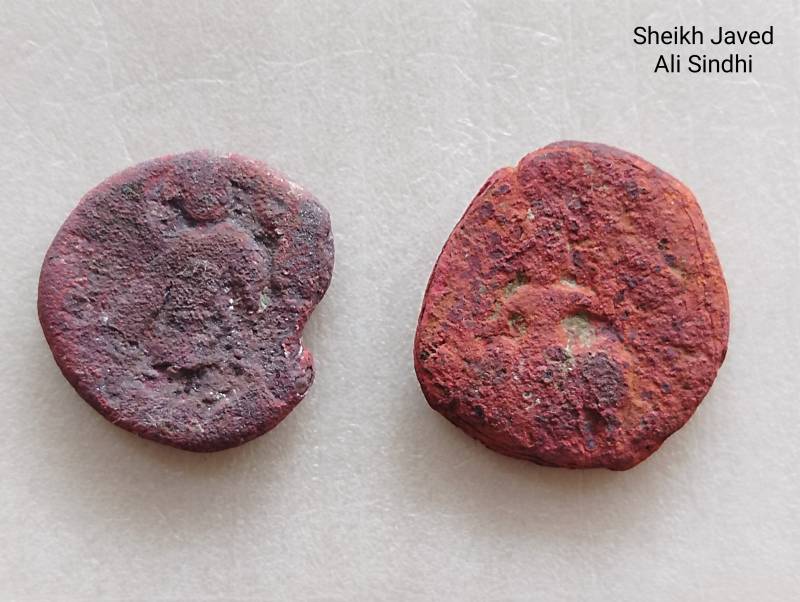
King Kanishka II Coin: This coin bears Kanishka II as a standing figure, trident above and fire altar on obverse. Ardochsho is seated on a throne, shown on the reverse side. Ardokhsho or Ardoxsho, the Iranic goddess of wealth, was a female deity of the Kushan Empire. She is considered an east Iranian goddess and alternate name of Lakshmi Devi. She is known in the Avesta as Ashi. As this figure is found rusted on copper coins, experts believe it a heart shape, pipal leaf or mushroom. This shape is also found on copper coins issued by Vima Takto (90-113 AD), Huvishka (151-190 AD) and Vasudeva II (270-300 AD). We can say that this copper hoard belongs to the 2nd to 3rd century AD. Further examination, investigation and research can provide more details.
Kushano-Sasanian Coin: One coin from the hoard seems to be a coin of the Kushano Sasanians. But it is difficult to identify the ruler with certainty. Sindh was part of the Kushano Sasanian realm which spread from Oxus River Valley to the Indus and beyond the Ganges River in the east.
The Sasanians started ruling Gandhara and the Indus Valley after the end of the Great Kushans. Ardeshir Papakan, Shahpur I, Shahpur II, Ardeshir, Shahpur III, Behram IV, Yazdegard, Behram V (Behram Gur), Yazdagard II, Hormuzd III, Piroj I, Palash, Kobad I and Jamasp ruled Iran at this time. After them, Khosrow I (Anushirvan) ascended the throne. Prophet Muhammad (PBUH) was born during the reign of this great monarch. After Khosrow I, his son Hormuzd IV came to the throne. After him his son Khusrow II, commonly known as Khusro Parviz became Shah. Artakshir III, Shahrbaraz Khusro III, Queen Purandokht, Zurvanshah Gushnaband, Queen Azarmidokht, Farrokhzad (Khusro IV), Peroj II, Khurzad Khusro and Hormuzd V continued to rule Iran and its vast Sasanian Empire.
In 632 AD, the last Sasanian Emperor Yezdegard III, the son of Sheheryar, grandson of Khusro Parviz, ascended the throne at the age of 21. He was a follower of Zoroastrianism. During his rule in 636 AD the first battle was fought near Qadisya/Kufa (Iraq) between Arabs and Persians. He sent envoys to the Tang Chinese court for support but couldn’t get it in a timely manner.
The Sasanian king Yezdegard III (d 651AD) and his Commander Rustam were defeated and the Arabs took captive a daughter of the Persian King called Princess Shahar Banu. According to Ibn Qutaybah, she was one of the wives of Imam Hussain Ibn Ali (AS), the grandson of Prophet Muhammad (PBUH). It is believed that her mother Mah Talat was a family member of the Buddhist Rai Dynasty of Sindh. She was mother of Imam Ali ibn al Hussain Zayn al Abidin (AS), 54, who died after the tragedy of Karbala on 13 October 713 AD.
Measures to protect the coin hoard
These copper coins of the Kushan period should be cleaned and treated technically. Then, after technical work, all copper coins discovered should be displayed in the Mohenjo-Daro Museum
A catalogue of these Kushan coins should be prepared and published for heritage promotion.

